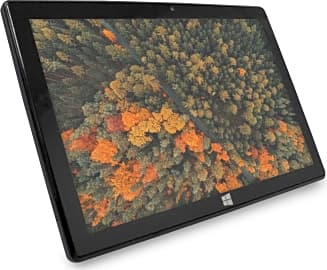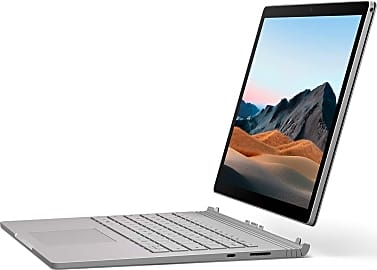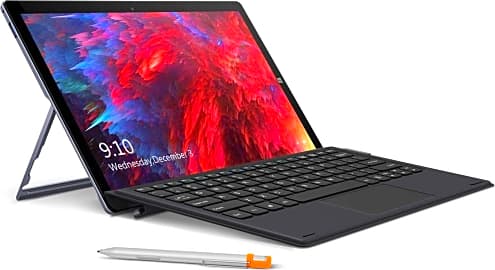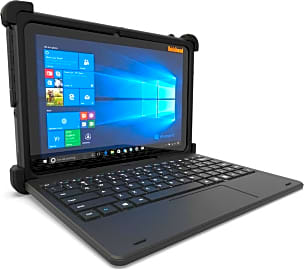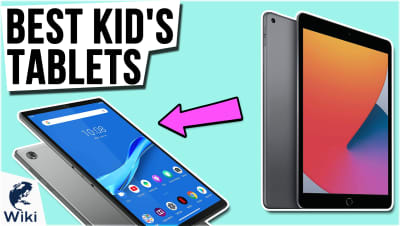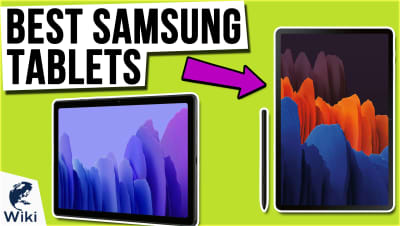The 6 Best Windows Tablets

This wiki has been updated 39 times since it was first published in April of 2015. Since the tablet PC has gone mainstream, manufacturers have continued loading the best of their technologies into these small packages. The performance of these cutting-edge machines is more important than ever, because Windows 10 is a truly powerful operating system. We've selected models that are capable of taking advantage of the most useful features Microsoft has to offer. When users buy our independently chosen editorial picks, we may earn commissions to help fund the Wiki.
Editor's Notes
December 25, 2020:
From time to time, you'll see a variety of Windows tablets released and then quickly discontinued. This is because many of them either just don't have enough firepower to run Windows well, or have significant reliability and consistency issues, or both. Of course, the Microsoft Surface Go 2, Microsoft Surface Pro 7, and Microsoft Surface Book 3 are understandably not part of that group, as they're engineered by the same company that publishes the operating system. Alternatively, the Chuwi UBook is a reasonably capable detachable 2-in-1 laptop in the same mold as the older Microsoft Surface models, and it's not exactly powerful, but it does work for many uses. If you'll only be using low-intensity programs, though, the Fusion5 FWIN232 is worth a look, and its moderate performance is almost certainly worth the low price, at least for some use cases.
May 30, 2019:
First of all, there's one big note of caution when buying a Windows tablet. Do not, under any circumstances, buy a tablet with only 64 gigabytes of internal storage. Yes, Microsoft themselves sells a Surface Go with a 64GB drive. To be perfectly honest, we're not really sure why, as this is barely enough room to fit the operating system itself. Install one or two moderate-size programs and the drive speed will tank, rendering the experience very frustrating. And while 128 gigabytes is enough to load and run the OS without difficulty, we'd strongly recommend grabbing a decently large microSD card to go along with the tablet as storage. Also, don't waste your time on any machines with ARM processors, sometimes known as the Snapdragon family. They just aren't powerful enough to run Windows -- yet. There may come a day when a Windows tablet can run for 24 hours without recharging, but it is not this day. You have been warned.
With those things being said, Microsoft makes a handful of devices that, unsurprisingly, offer an excellent Windows experience. The Surface Book 2, Surface Pro 6, and Surface Go are, in that order, absurdly powerful, incredibly versatile, and especially portable. You can even play some pretty graphics-intensive games on the Surface Book 2.
If you want a little better bang for your buck, the Lenovo Miix, Samsung Galaxy Book, and Asus Transformer Mini are worth a look. The first two are remarkably similar to ultralight laptops, while the Asus is a bit smaller than those, and also a bit slower. It's still quite functional. The Samsung Galaxy TabPro S is one of the slimmest and lightest outside of the Surface Go, and its screen looks especially great thanks to its incredible pixel density.
Meanwhile, it's not very recent, but the Acer Switch Alpha is essentially a clone of the Surface Pro 4, and for its cost, it makes a surprisingly good everyday computer. I've personally used one every day for over a year now; it's a bit heavy and the battery life is pretty poor, but it's never once performed slowly or hesitated to open programs or complete commands. In fact, I like it so much that I went ahead and got a second one when I dropped the first one (pro tip: don't drop your laptop, kids). You'll be hard-pressed to find anything else with 8 GB of RAM and a 256GB SSD for that price.
Finally, the HP Spectre x360 is too good of a machine to not consider. It's one of the few 4K 2-in-1s worth its salt, it's packed with ultra-fast components, and it's visually stunning to look at in person. But, it will cost you a considerable amount of dough.
Special Honors
Asus ROG Mothership This high-powered detachable laptop is designed specifically for high-end gaming. It's packed with immensely powerful hardware that can tackle today's most demanding titles, but it's especially heavy and remarkably expensive. rog.asus.com
Lenovo ThinkPad X1 Fold The first of its kind, this novel device features a folding, 13.3-inch OLED screen and some of the most efficient components on the planet. Early adopters might be very interested in this one, but keep in mind that it costs an incredible amount, plus, the mated keyboard drains the battery very quickly. lenovo.com
The Little Computer That Could
All of these developments, plus an influx of competing software developers, turned the tablet PC into the all-purpose, incredibly useful tool we've come to love.
Ever since early desktop PCs were introduced, engineers have been developing ways to pack more and more power into end-user computers. From the first bulky IBM dinosaurs to the release of the svelte iMac and today's high-end gaming rigs, that power has often been built into stable, desktop configurations. These heavy beasts have many purposes–server housing, network workstations, high-resolution 3-D graphics–and they serve them well. Yet, so many times, users need something smaller and more portable for simpler tasks.
Enter: the tablet computer.
While tablets have been around for over 20 years, they haven't always been very popular. Steve Jobs may have foreseen a "great computer in a book" as early as 1983, but most early models were too heavy and lacked the functionality and battery life needed to be worthwhile. They were bulky, with pixellated screens, and different brands often lacked easy compatibility with each other. Many companies tried their hands, notably Palm, Nokia, and, in 2002, Microsoft itself. However, It would be an entire 27 years after Jobs' prediction before Apple released the iPad and redefined the landscape. Many experts say that this iconic moment helped move a niche gadget toward what we know today as the tablet computer. Immediately, many companies followed suit and the market became flooded with lightweight, powerful options.
Initially, many were geared for purposes like e-reading, video and photo capture, web browsing, and e-mail. As Moore's Law still continued (to some effect, at least) to prove correct that CPUs would become faster every year, the capabilities of these little devices grew quickly. Advances in solid-state drives allowed for greater amounts of storage, while screens became clearer and higher-resolution than ever before. The accuracy of the touchscreen, which had long been a major drawback to tablet computing, was exponentially improved. Many new models were equipped with wireless broadband capabilities from the beginning. All of these developments, plus an influx of competing software developers, turned the tablet PC into the all-purpose, incredibly useful tool we've come to love.
What's So Great About These Tablets, Anyway?
There are many potential uses for slim and convenient mobile PCs. Nearly every electrical appliance in the modern home is available with wireless connectivity, whether via Bluetooth or a Wi-Fi network. A compact, portable visual interface like a tablet lets you program the thermostat, set the alarm, change the channel on your TV, or even turn on your sprinklers. Chefs can easily monitor the temperature of their outdoor hardwood smoker without having to leave the kitchen. Audio engineers have the freedom to check the sound from every position in a concert hall, bringing attendees and performers the best possible sound quality. At project presentations and high-stakes contract pitches, you'll have near-endless multimedia features at your fingertips. Taking notes in class or at board meetings is simple and unobtrusive, thanks to the ever-shrinking form factor of these computers. Video conferencing and telecommuting, as well, have never been easier than with these modern machines.
To this day, Microsoft provides users with highly capable and multifunctional computers that are compact, ultra-lightweight, and easy to use.
Today's tablets are constantly evolving and competing, with innovation always pushing the envelope of what they can do. Since the significant evolution of the device in 2010, new manufacturers have cropped up regularly and others have liquidated flagship lines that failed to sell. Yet, there have always been some power players in the computing industry who keep coming back. So, it's no surprise that Microsoft, after the generally unimpressive and quickly discontinued Microsoft Tablet PC from the early 2000s, would return to grab a significant market share from a crowded field. Partially due to the ubiquity of its famous OS, Windows, and also thanks to the evolving ingenuity of programmers and coders, it's continued to thrive in the world of tablets.
To this day, Microsoft provides users with highly capable and multifunctional computers that are compact, ultra-lightweight, and easy to use. It's developed operating systems that take advantage of precision touchscreen and gesture-command capabilities. Its engineering team's constant support updates help to ensure that its products are safe from the most aggressive or unsavory bugs and security breaches. High-speed internet can be available around the world with mobile broadband access. Still, these apparent hybrids of smartphones and notebooks are worth even more than just their portability, convenience, or connectivity. They allow professionals across all disciplines to integrate their work and skills with those of their colleagues and community.
So, Which One's Right For Me?
There's a number of different styles of tablet design that suit different needs. The classic slate design is usually the first layout that comes to mind. These are simple and often very thin units that can measure as much as 18 inches diagonally. Miniature versions of these tablets, pioneered by groundbreaking products like Amazon's Kindle and Barnes & Noble's Nook, are popular for e-reading, retail transactions, and on-the-go note-taking, thanks to their very low profiles and light weights.
Screen resolutions also vary, so if you're planning to consume a lot of HD media on your tablet, make sure to choose a model that offers true 1080p video quality or higher.
Some models other than the slate come with physical keyboards, like the elegant booklets that flip open and allow stable, comfortable use just like a laptop computer would. Other styles have keyboards that can be hidden or even detached during use, adding to their versatility. The largest of these convertible designs, known as 2-in-1s or hybrids, are somewhat similar to notebook computers and can serve many of the same purposes.
Considering that the smallest tablets are essentially tablet/smartphone blends, we can't expect to find an exhaustive selection of connection ports on all of these mobile devices. You will, however, find some with HDMI output, as well as high-speed USB 3.1 ports. Screen resolutions also vary, so if you're planning to consume a lot of HD media on your tablet, make sure to choose a model that offers true 1080p video quality or higher.
It's a foregone conclusion that digital technology will continue to grow more efficient over time. Ever-smaller and faster chip designs promise constant increases in power and functionality in mobile computing for years to come. A quality Windows tablet can help you stay ahead of that curve.



